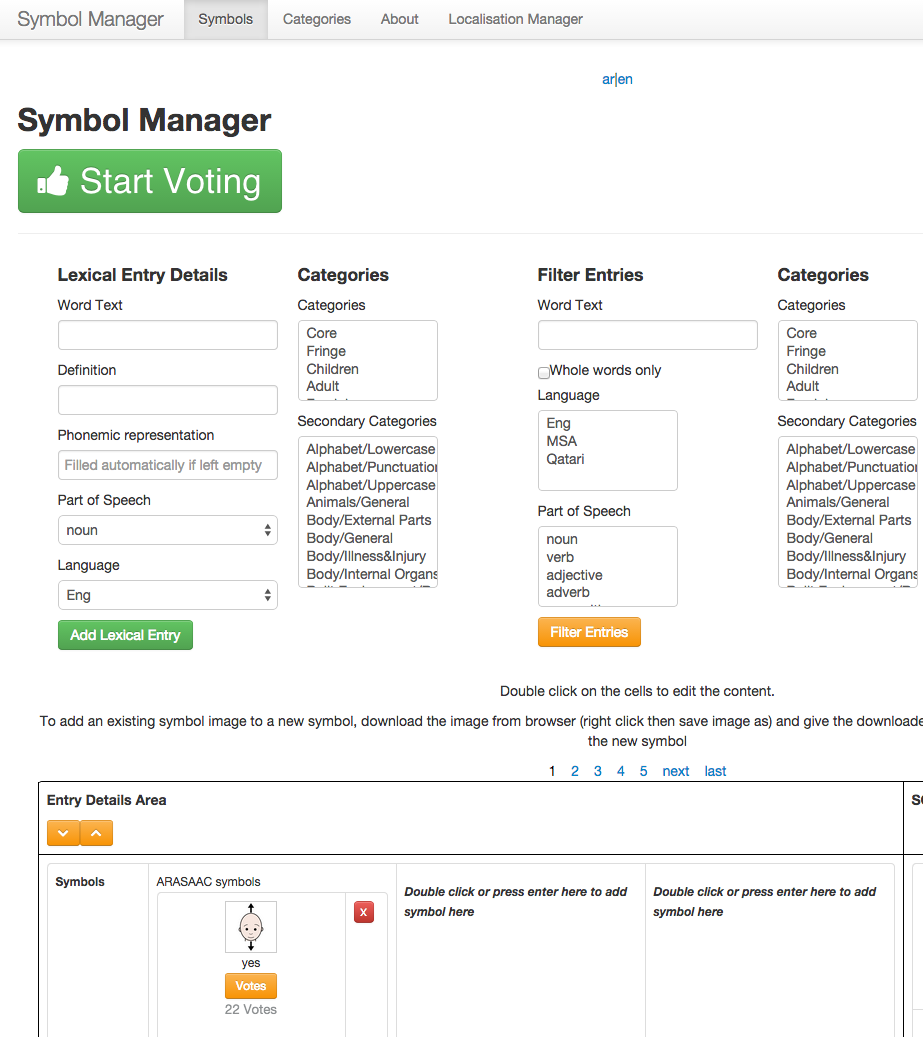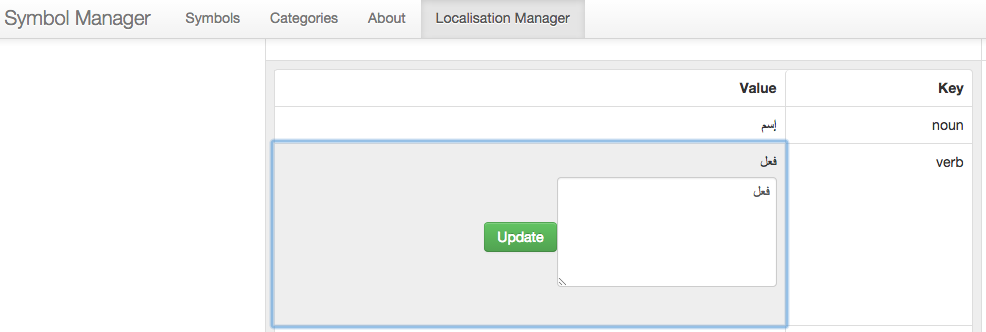 Having discussed changes to the Symbol Manager over the last month the work has been completed with categories being divided into small lists and alphabetic versions of the sub-categories used by ARASAAC. Those not needed for the Arabic Symbol Dictionary have been hidden and others have been added – mainly related to food complement some of the categories the therapists have been using with Boardmaker.
Having discussed changes to the Symbol Manager over the last month the work has been completed with categories being divided into small lists and alphabetic versions of the sub-categories used by ARASAAC. Those not needed for the Arabic Symbol Dictionary have been hidden and others have been added – mainly related to food complement some of the categories the therapists have been using with Boardmaker.
There is now a Localisation section of the Symbol Manager that allows all the elements of the site to be translated from English to Arabic with changes that can be made at any time should the need arise.
There have been discussions about adding definitions for each lexical entry as it was clear that the WordNet entries in English needed some changes to suit the audience of AAC symbol users and that an Arabic dictionary was also needed. A request was made to the Almaany Dictionary and they have kindly offered collaboration which will be incredibly helpful.
Recent visits to Awsaj Academy have resulted in more vocabulary lists being provided by the Arabic department, for which we are incredibly grateful as this has allowed us to compare the use of various parts of speech in the lists provided by English teachers and those teaching in Arabic when using symbol communication. But we need to be wary of the results as they come from a wide range of ages and this last list comes from a group of more able children compared to those in the earlier samples. However, all the centres and schools need core and fringe Arabic vocabularies to provide a base for the most commonly used symbols. So frequency of use will be of paramount importance when making the choices of which symbols to adapt to suit the culture, environment, language and personal requirements.
Percentage |
Number of words |
Parts of Speech |
| 12% | 54 | adjectives |
| 2% | 7 | adverbs |
| 3% | 15 | interjections |
| 48% | 209 | nouns |
| 1% | 5 | prepositions |
| 1% | 6 | pronouns |
| 1% | 5 | question words |
| 32% | 138 | verbs |
| Total | 439 | |
A VOIP meeting with the ARASAAC team discussed the collaboration on the adaptation of symbols. They have kindly agreed to give us some guidance as to how they develop their symbols and we will send them our list of symbol files that need to be added to the database to suit the needs of users in Doha and the Arabic culture, language and environment. Sharing .svg files will help with the development and ARASAAC are changing their website and database in the coming months.
 One of the ways we have been working on symbols that has greatly speeded up interaction between team members has been the use of Google+ with images being uploaded and our votes and comments being monitored by Dana before she finally uploads the images to the Symbol Manager for voting by the AAC Forum.
One of the ways we have been working on symbols that has greatly speeded up interaction between team members has been the use of Google+ with images being uploaded and our votes and comments being monitored by Dana before she finally uploads the images to the Symbol Manager for voting by the AAC Forum.
On going research into issues around voting as to the iconicity of symbols will confirm our decisions around how the AAC Forum can vote on the final draft versions of the symbols. At present we have several options as illustrated in the slides below that are available on SlideShare.
References
Bloomberg, K., Karlan, G. R., Llloyd, L. L.: The comparative translucency of initial lexical items represented in five graphic symbol systems and sets. Journal of Speech and Hearing Research, Vol. 33 (1990), 717-725
Evans D, Bowick L, Johnson M, Blenkhorn P (2006) Using iconicity to evaluate symbol use. In: Proceedings of the 10th international conference on computers helping people. Linz, Austria, pp 874–881
Fuller, D. R.: Initial study into the effects of translucency and complexity on the learning of Blissymbols by children and adults with normal cognitive abilities. Augmentative and Alternative Communication, Vol. 7, (1997), 30-39
Haupt, L., Alant, E.: The iconicity of picture communication symbols for rural Zulu children. South African Journal of Communication Disorders, Vol. 49 (2003), 40-49
Huer, M. B.: Examining perceptions of graphic symbols across cultures: preliminary study of the impact of culture/ethnicity. Augmentative and Alternative Communication, Vol. 16 (2000), 180-185
Mizuko, M.: Transparency and ease of learning of symbols represented by Blissymbols, PCS and Picsysms. Augmentative and Alternative Communication, Vol. 3 (1987), 129-136
Musselwhite, C. R., Ruscello, D. M.: Transparency of three communication symbol systems. Journal of Speech and Hearing Research, Vol. 27, (1984), 436-443

